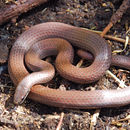en
names in breadcrumbs


US Federal List: no special status
CITES: no special status
IUCN Red List of Threatened Species: least concern
None.
C. tenuis has no major economic importance, but may be adapting to live around rural and suburban gardens, where they feed on abundant non-native slug species (Morey 1989).
Slugs are the primary food of the Sharp-tailed Snake.
Although there are no observations of C. tenuis preying on
any other species, it is suggested that snails and small
plethodontid salamanders may also be taken. The Sharp-tailed Snake may use the spine on its tail to brace itself while capturing its prey. Long, needle-like teeth on its mandibles are noted as an adaptation to gripping and eating slugs (Mattison 1995; Stebbins 1954; Greene 1997).
The Sharp-tailed Snake (Contia tenuis) is a North American species generally found in the Sierra Nevada Mountain Range from southern California to southern British Columbia and along the Pacific Coast of California. In California, this species can be found in and along the mountains from Eureka to central San Luis Obispo, and along western slope of the Sierras in the foothills and at middle to low elevations (max altitude 2130 m (7000 ft.) (Leviton 1971; Morey 1989).
Biogeographic Regions: nearctic (Native )
Sharp-tailed Snakes occur in a variety of habitats, however, they are most commonly found in moist environments with an abundance of surface debris, such as twigs, roots, and leaves. The Sharp-tailed Snake is found in areas with surface moisture and it becomes active during the cool fall and winter temperatures. Because of their preference for cooler temperatures and higher moisture levels, C. tenuis is active at different times and in different microhabitats than most snakes. However, its range overlaps that of the Ring-neck Snake(Diadophis punctatus), and they can be found under the same cover at times. The Sharp-tailed Snake can be found mainly in wooded areas or near intermittent streams (Leviton 1971; Morey 1989; Basey 1976).
Terrestrial Biomes: savanna or grassland ; chaparral ; forest ; mountains
At maximum, the Sharp-tailed Snake may grow to a length of 19 inches (47.5cm), but most adults are about 12 inches (30cm) long. Shiny reddish-brown or gray scales above and a whitish line down the side characterize C. tenuis. An alternating pattern of black, pale greenish, gray, or cream bars can be found on its belly, and its smooth scales come in 15 rows around the body. The most distinguishing characteristic of this snake is the sharp spine-like scale at the tip of its tail. Although the function of this scale is not completely understood, it is thought to be used as an anchor during struggles with its victims (Basey 1976; Leviton 1971).
Habitat requirements for reproduction are unknown. Mating
of the Sharp-tailed Snake occurs in spring and in the
summer it lays 3-8 eggs. There is evidence that indicates that on occasion, eggs are laid in communal nest sites. Hatching occurs in the fall, and the egg clutches can be found in 7 to 15cm (2.8 to 6 in.) of soil, among grass roots and deep in rock outcrops (Morey 1989; Basey 1976; Nussbaum et al. 1983).
The sharp-tailed snake or sharptail snake (Contia tenuis) is a small species of snake in the family Colubridae. The species is endemic to the Western United States and British Columbia.
Additional common names for C. tenuis include brown snake, gentle brown snake, Oregon worm snake, Pacific brown snake, Pacific ground snake, and purple-tailed snake.[4]
C. tenuis is distributed through the states of California, Oregon, and Washington, as well as British Columbia, Canada: Southern Vancouver Island, British Columbia around Victoria, British Columbia,[5] and a newly discovered site in Pemberton, British Columbia.[6][7]
The sharp-tailed snake has an average total length (including tail) of 12–18 in (30–46 cm) as an adult. It is distinguished by its sharp tail spine, which is the protruding tip of the last tail vertebra. The spine is not toxic and cannot injure humans. Rather, the tail is used to stabilize small prey, such as slugs, for consumption. The dorsal surface ranges in color from grayish brown to brown to brick red, with bubble-gum pink and peachy-orange specimens occasionally found. The ventral surface is a striking series of black and white crossbars.[8]
The sharp-tailed snake is a shy, secretive creature most often encountered under rocks and logs, and rarely to never found in the open.[8] It is able to persist in urban areas where appropriate cover can be found. It is known to burrow into soft soil or cracks in the clay, and may be encountered by people who are digging in the garden or removing concrete. When encountered, the sharp-tailed snake may roll into a ball and remain still. It can be mistaken for a worm by the casual observer.
The diet of C. tenuis is largely restricted to slugs and eggs of slugs. It sometimes also eats insects and earthworms.[8]
The adult female C. tenuis lays 4–16 eggs in the summer, underground or in a burrow. Each hatchling is 3–4 in (7.6–10.2 cm) in total length (including tail).
The sharp-tailed snake or sharptail snake (Contia tenuis) is a small species of snake in the family Colubridae. The species is endemic to the Western United States and British Columbia.